Briefly: In our opinion, short (full) speculative positions in gold, silver and mining stocks are justified from the risk/reward point of view.
The New Year brings new plans and new expectations. In the case of the markets, we have a very specific situation, because on one hand a myriad of new factors can emerge and change the investment landscape, but on the other hand, we’ve been through way too many “totally different” scenarios, which turned out to be a repeat of some previous developments. What’s going to happen this year? While this question can never be answered with 100% certainty, thankfully to the careful analysis of previous patterns we can estimate what’s likely to happen. Let’s move right to it (charts courtesy of http://stockcharts.com).
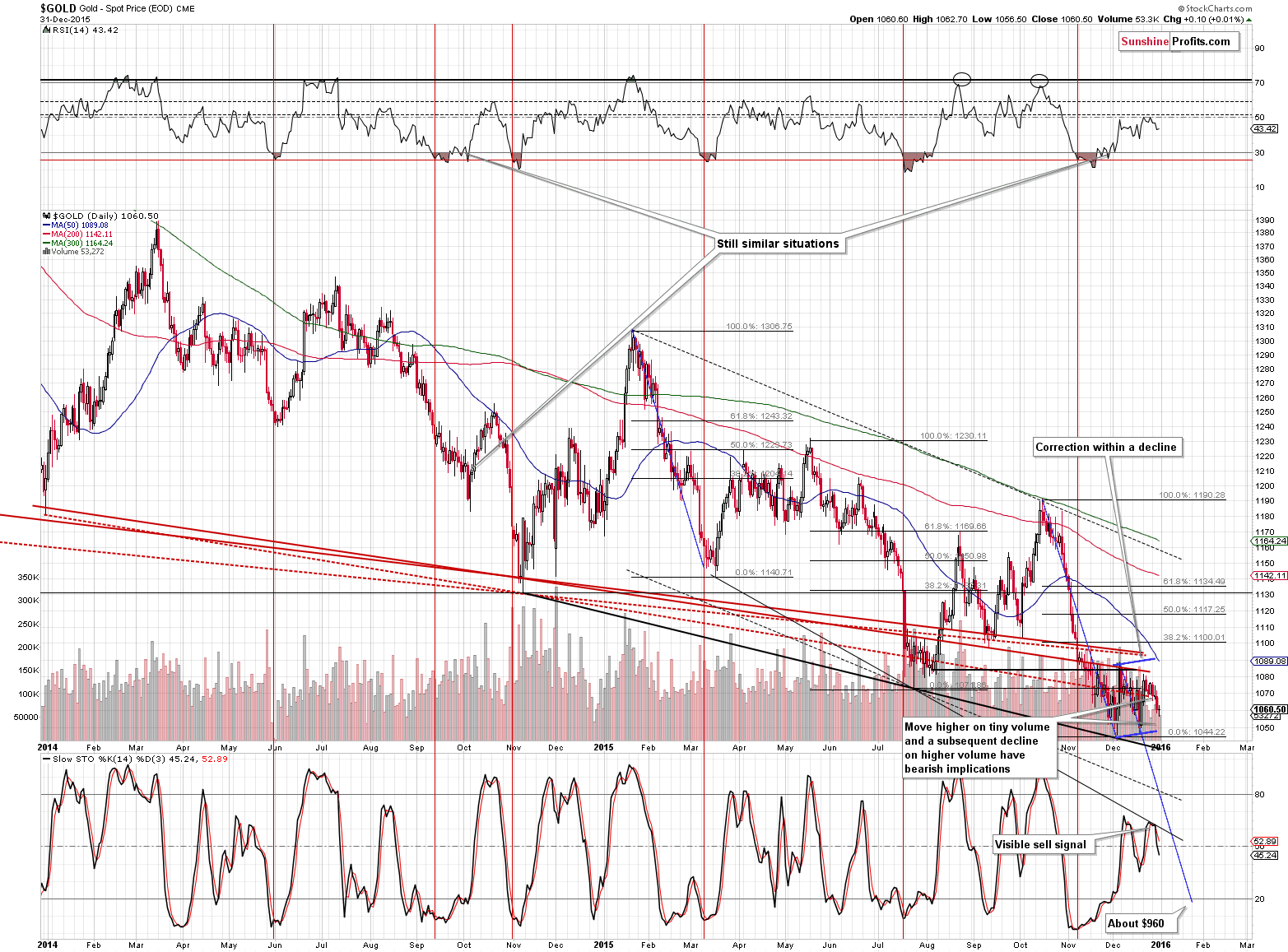
In the previous alert we wrote the following:
Gold declined more visibly yesterday and the decline took place on relatively high volume. The implications are bearish and we can say the same about the implications of the sell signal from the daily Stochastic indicator.
We still can’t rule out a corrective, temporary move higher toward the rising blue line and the 50-day moving average (at about $1,090), but it seems more likely that a big decline will follow even without another small rally.
The above remains up-to-date. On Thursday we saw a tiny move higher on relatively low volume, which is rather inconsequential. The sell signal from the Stochastic indicator remains in place and the medium-term trend remains down.
At the moment of writing these words gold has moved about $10 higher (to $1,072) as the USD Index has declined, which doesn’t change anything, in our opinion.
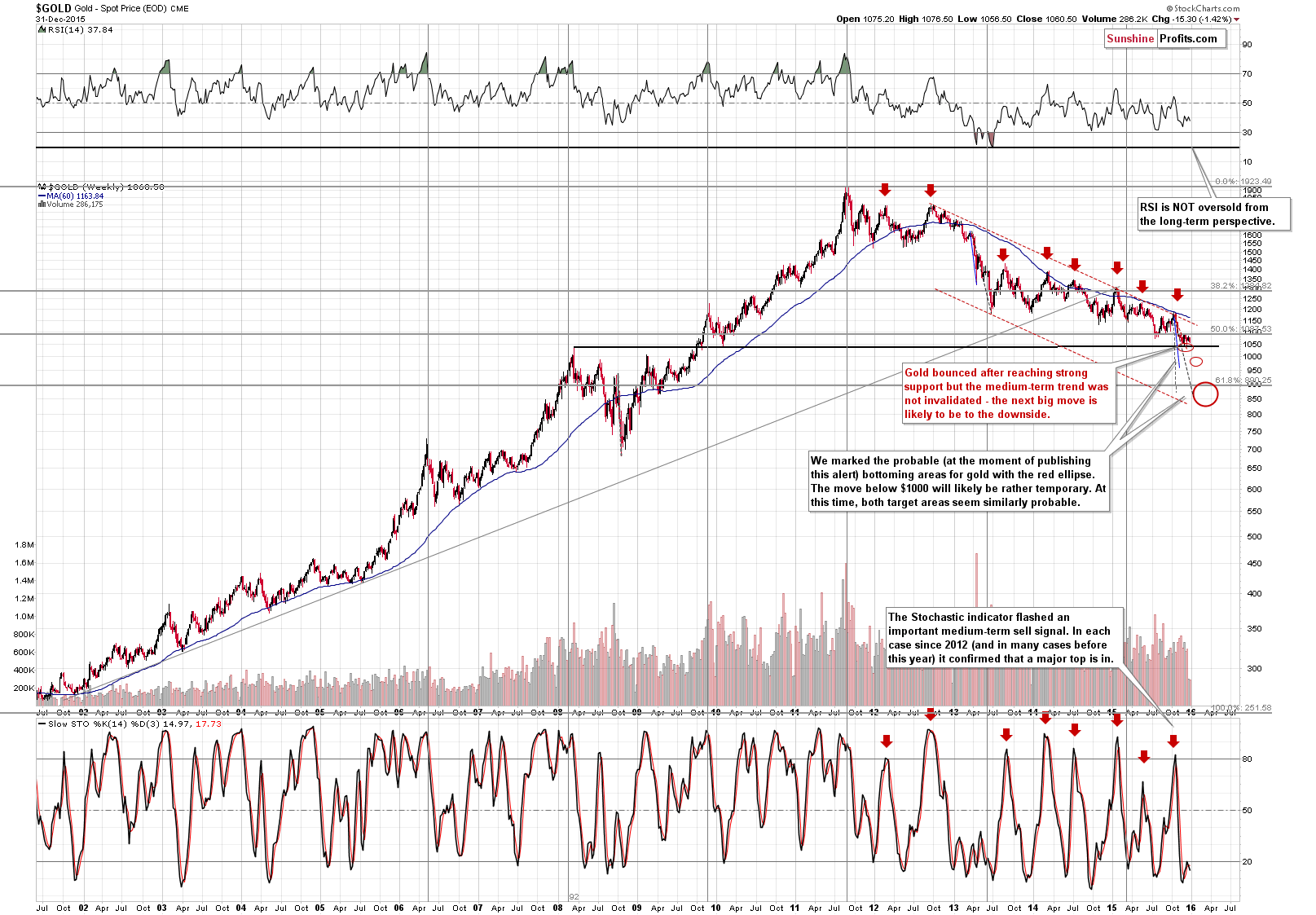
The long-term chart didn’t change much recently. Gold is still below the 50% Fibonacci retracement based on the entire bull market, the trend remains down, and gold is very close to its previous lows. In our opinion, the situation seems quite similar to what we saw 3 years ago – gold moved a bit higher after the initial bottom, but it turned out that it was actually a pause before a much bigger and much more significant slide lower.
Gold declined more than $15 last week and the sell signal from the weekly version of the Stochastic indicator remains in place. In fact, the situation is more bearish as the signal is now more visible.
In the past 2 years and in early 2012 gold moved higher in January and we are receiving questions whether or not that has important bullish consequences right now. In short, we don’t think that the implications are very meaningful or very bullish. The reason is that the current situation is not really like it was in early 2012, 2014 or 2015 – it’s much more like it was in early 2013 and thus the analogy to this year seems more important. Why? Because in all the “other” cases (2012, 2014 and 2015) gold was after an invalidation of a breakdown below a major low. This is not the case right now. In fact, gold moved well below the previous 2015 low and has been trading below it for about a month now (with some small exceptions depending on how one decides to define the previous 2015 bottom). Either way, in early 2012, 2014 and 2015, the invalidations were clear and thus the situation was very much different. The position of the Stochastic indicator at this time (sell signal) also suggests that it is the 2013 that we should be focusing on, not the other recent years.
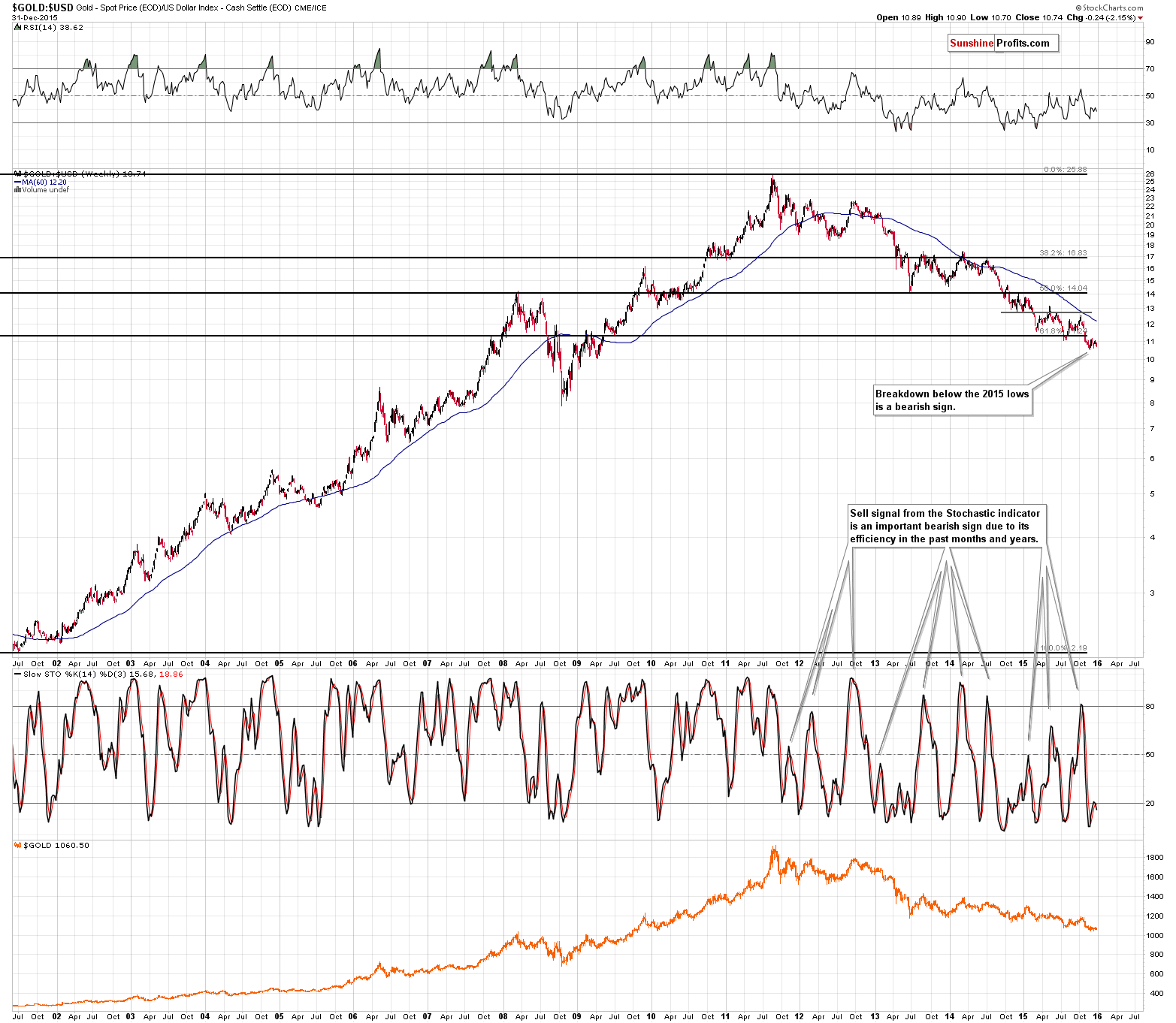
Speaking of sell signals, we saw one also in the case of the gold:USD ratio. This ratio doesn’t have a meaningful fundamental interpretation, but it’s helpful for technical analysis and confirmations / invalidations of other signals. At this time, the ratio is consolidating after breaking below a key support level (the 61.8% Fibonacci retracement) and the previous lows. The outlook remains bearish.
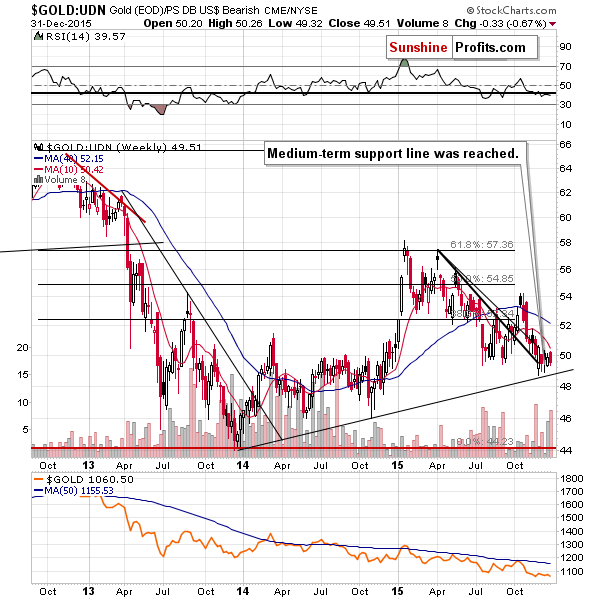
From the non-USD perspective (the average of gold prices in terms of currencies other than the USD) once again not much changed last week. Gold moved a little lower and more or less it’s been trading sideways for the past few weeks - the pause that we are currently seeing is not unexpected, as gold had previously moved to an important long-term support line. The medium-term trend remains down, though, so another big move lower is likely to be seen once the above ratio breaks below the rising support line.
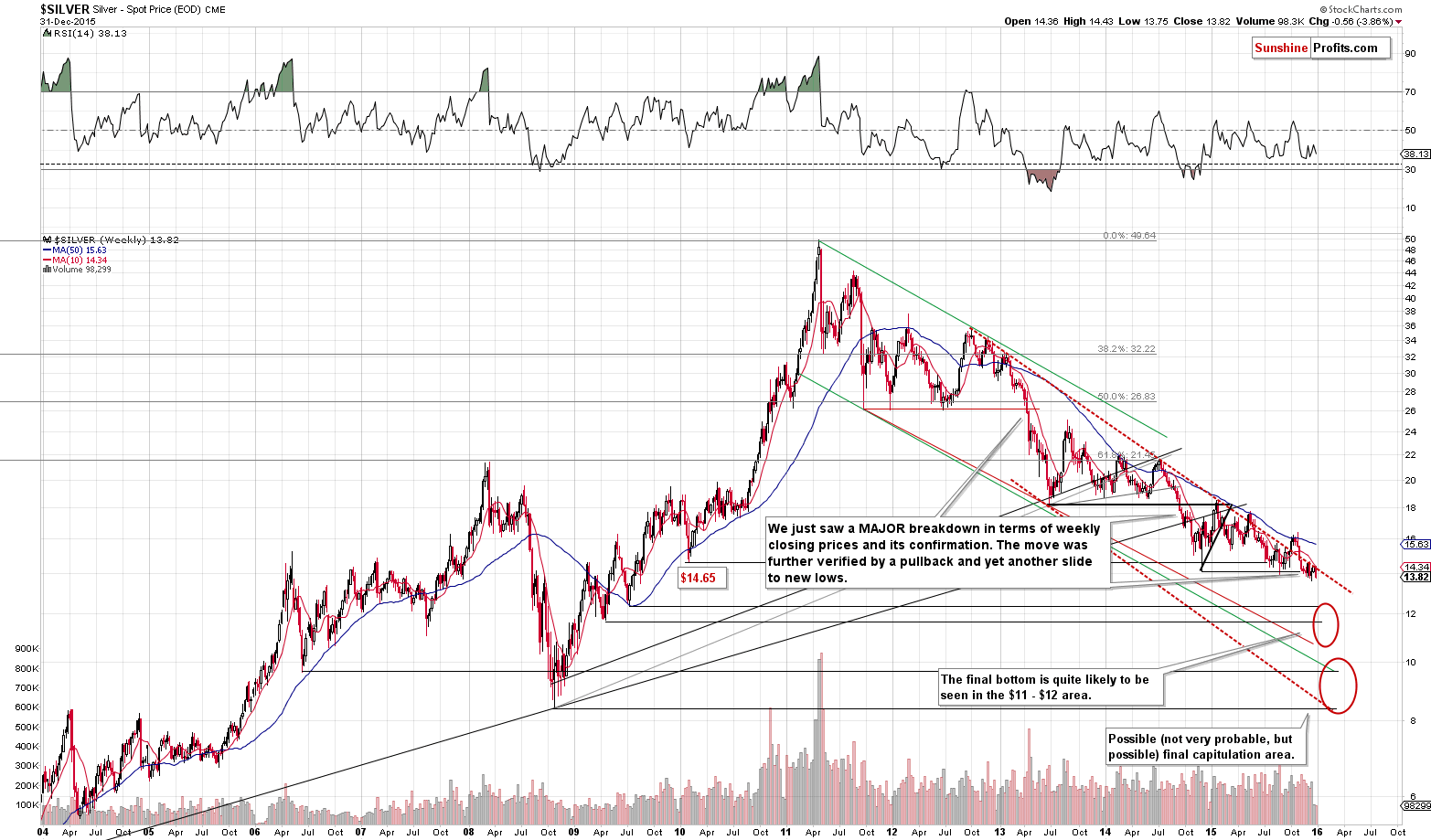
There’s not much that happened in silver on a daily basis on Thursday, so we’ll focus on the big picture.
The big picture tells us that silver just broke and closed the week (and year) below the previous weekly low (in terms of weekly closing prices). The implications are bearish.
Silver is now well below the mid-2013 and late-2014 lows and yet the RSI indicator is much higher, suggesting that there’s further room for additional declines without invalidating the previous patterns.
The next strong support is relatively far, so another downswing could be quite sharp.
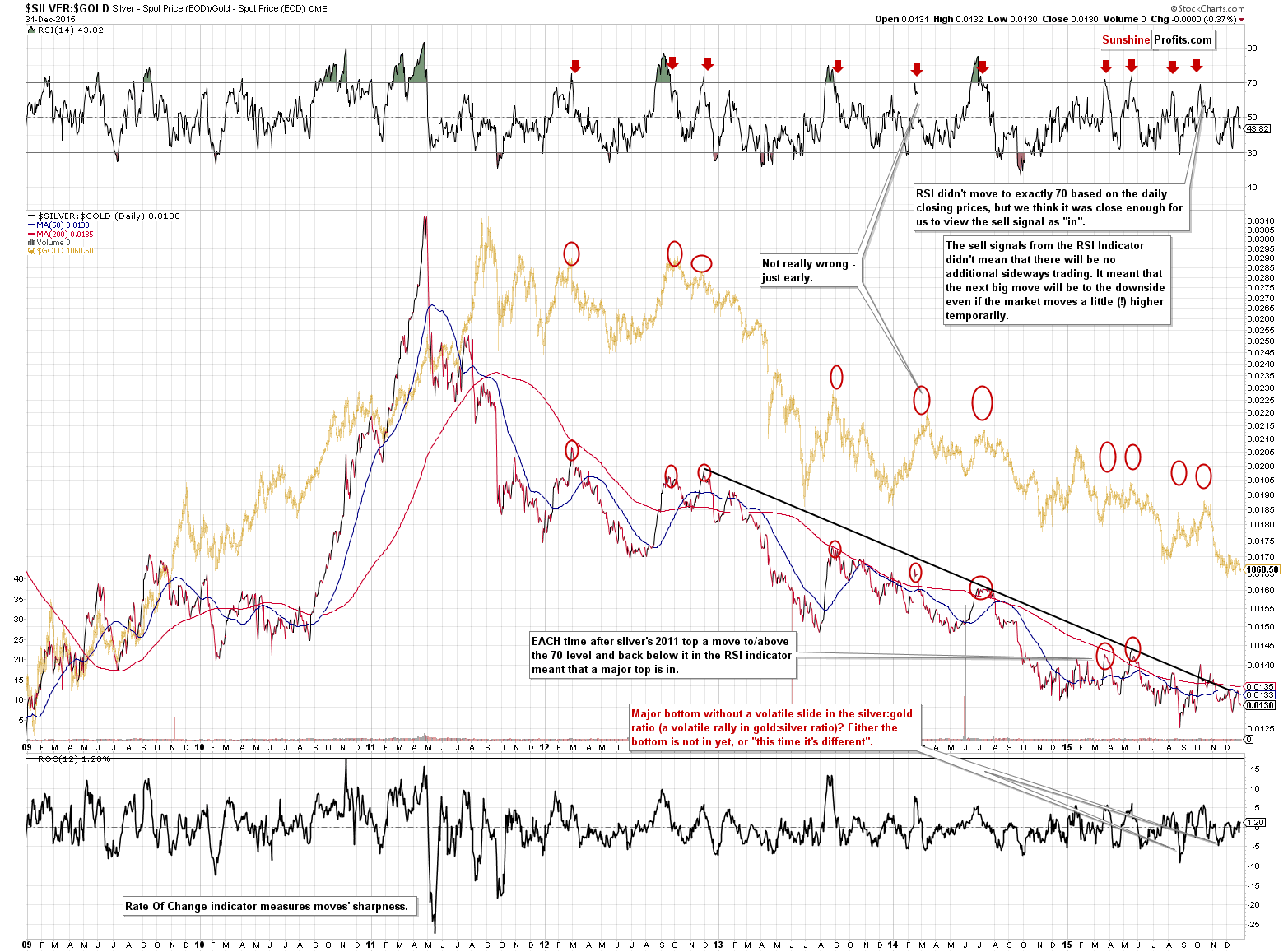
The analysis of the silver to gold ratio tells us one important thing – the final bottom is most likely still ahead of us as silver didn’t show any major underperformance relative to gold in the past months.
Having said that, let’s take a look at the mining stocks.
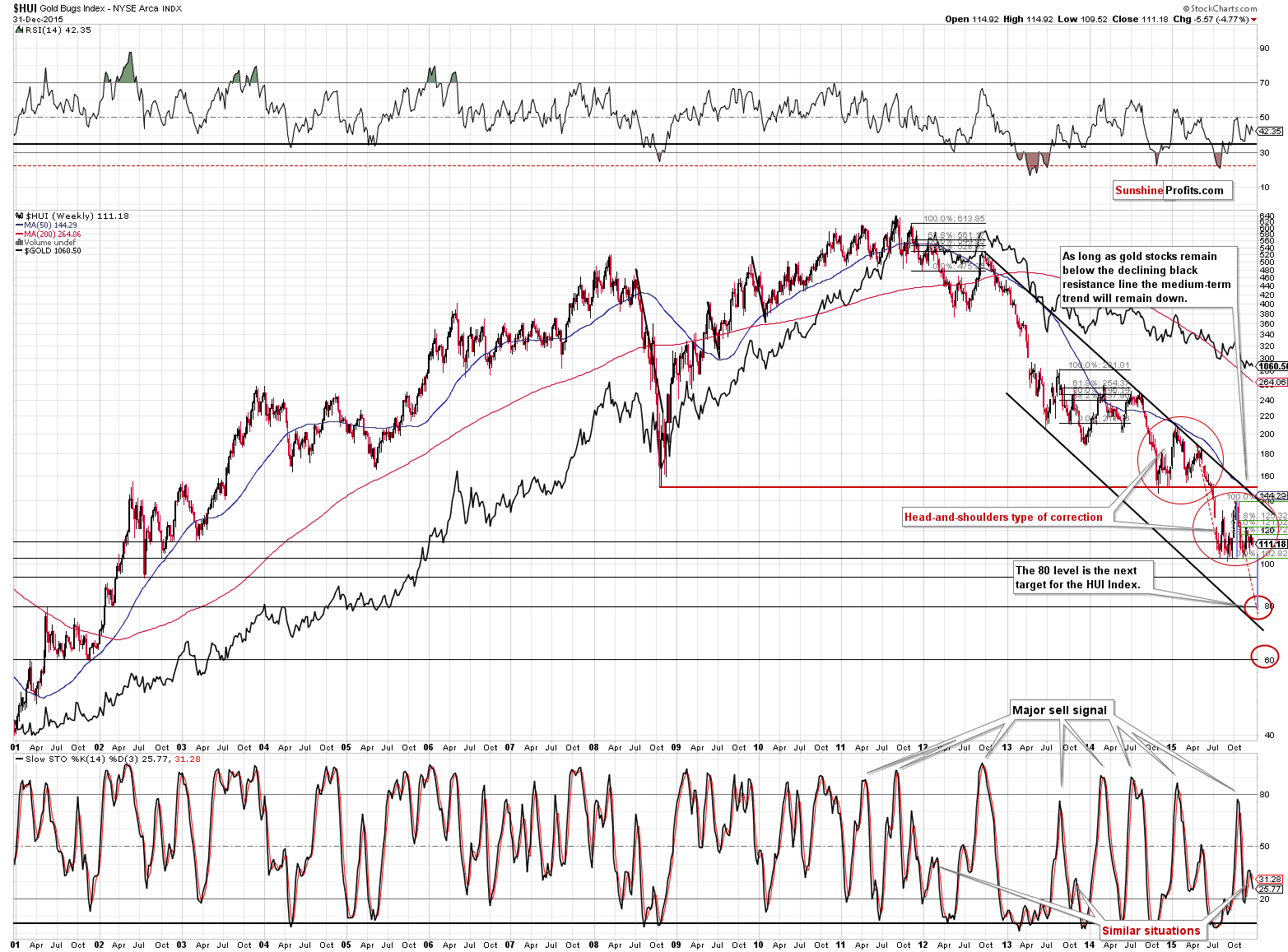
In short, not much changed from the long-term perspective as gold stocks moved lower, which was in tune with our expectations.
Our comments from last Monday’s alert remain up-to-date:
The HUI Index (…) is about to create a bearish head-and-shoulders pattern. The target based on this formation is the 80 level, which was our next interim target anyway based on the early 2002 low and other calculations (the gold price target and the gold stocks to gold ratio analysis). Consequently, this target is even more likely to really hold the decline (at least for some time). Please note that there is also another level to which gold stocks could decline – the 60 level.
It seems unrealistic – we know – but did 106 seem realistic when the HUI was trading above 600 just a few years ago? The fundamental outlook for the precious metals market remains bullish in our view, but that doesn’t change anything (!) regarding the short term or even the medium term, given a strong downtrend. Markets are logical only in the long run, and emotional in the short run. Consequently, it is possible for the HUI Index to become even more oversold than it is right now before the final bottom is in.
The thing that has indeed changed is that we just saw a sell signal from the weekly Stochastic indicator. This is a very important (as it’s been a reliable sell signal numerous times in the past) and bearish development for the following weeks.
The mentioned sell signal is now clearly visible and the implications are even more bearish than they were last week.
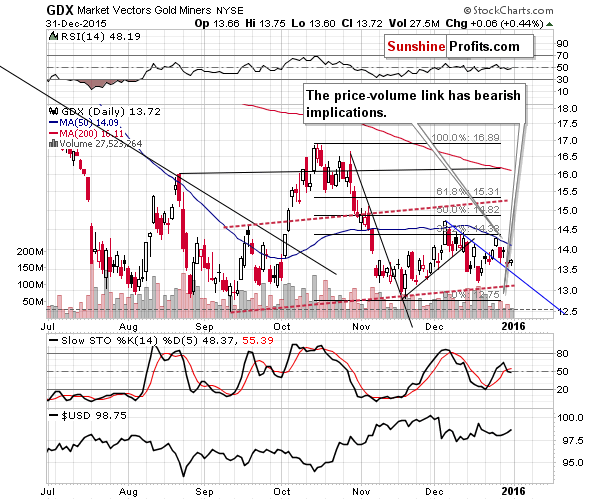
Mining stocks were flat on Thursday (moving higher only 6 cents in the case of the GDX ETF) and there are no meaningful implications thereof. As you can see on the previous long-term chart, the medium-term trend remains down and what we’re seeing since August 2015 is a big head-and-shoulders-shaped consolidation. The 50-day moving average has recently served as resistance and it seems that the next move will be to the downside. Naturally, we are watching the market for signs of short-term strength, but not seeing anything significant at this time.
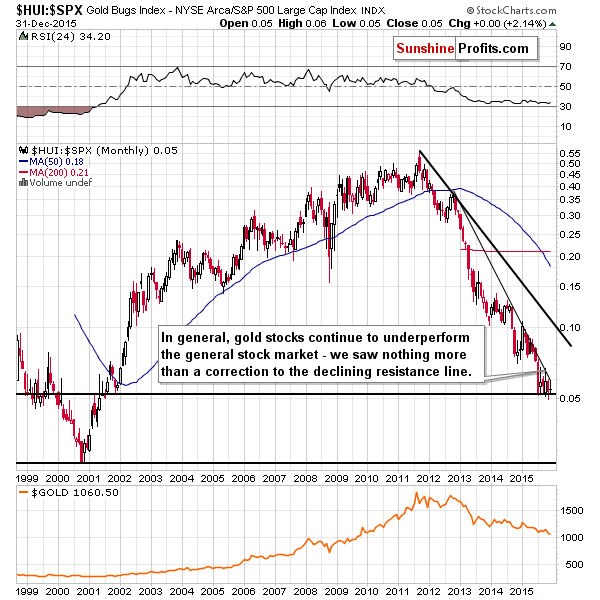
Moving back to the long-term perspective, we continue to see bearish implications of the situation in the HUI to S&P 500 ratio. The consolidation seems to be nearing its end and the odds are a breakdown will be seen, just like in early 2013, late 2014 and mid-2015.
Please note that once this ratio had broken below its previous lows, it plunged quickly and significantly – it was difficult to move back into the market with one’s short-term positions if one was waiting for a confirmation of the breakdown– once it was seen, the decline might have been almost over and the profit opportunity almost gone. This has important implications – it shows that being positioned to take advantage of the upcoming slide and staying in the market with the short position despite a risk of a very short-term corrective upswing is justified from the risk/reward point of view. This is exactly what we’re doing now – not focusing on day-trading, but on the major move that will likely be seen in the coming days or weeks.
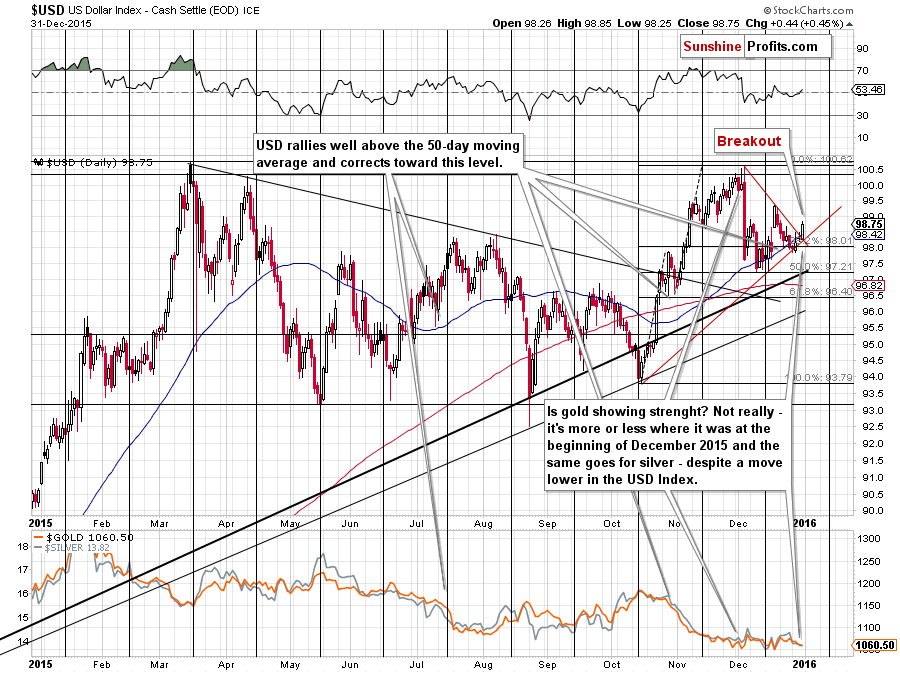
The implications from the analysis of the USD Index remain bearish and they have just deteriorated as the index has just broken above the declining resistance line (and today’s pre-market move to 98 or so doesn’t invalidate it – at least not yet). In the previous alert we wrote the following:
The USD Index moved once again lower, but didn’t move visibly below the 50-day moving average, the 38.2% Fibonacci retracement level and the index remains visibly above the rising support line. Based on the latter, the possible downside seems very limited. Consequently, it seems that the short-term upside for the precious metals sector is limited as well.
The USD Index moved right to the mentioned rising support line. Consequently, it’s unlikely that it will move even lower (visibly lower, that is) and the implications are bullish for the USD. The implications for the precious metals market are bearish.
The above remains up-to-date. The downside is limited and the implications of the situation in the USD Index are bearish for the precious metals sector.
Summing up, the medium-term outlook remains bearish and the short-term outlook deteriorated a bit based on last week’s action and increased visibility of the sell signals from the Stochastic indicator in the case of gold and the HUI Index. The breakout in the USD Index has bearish implications for PMs as well.
In our opinion, we are in a similar situation to what we saw in mid-August 2014, in mid-June this year, or in the final part of 2012. If the major move that is going to follow is to the downside, then a daily or relatively small upswing is not that relevant - it’s most important not to miss the big move and thus the speculative short position seems to be justified from the risk/reward perspective. It seems that the current speculative short position in the precious metals sector will prove very profitable in the following weeks even if this will not be the case for the next few days. After all, our target of $960 in gold is well below the current market price and if the analogy to the 2013 slide is indeed in place, then we will likely not have to wait long before this level is reached.
As always, we will keep you – our subscribers – updated.
To summarize:
Trading capital (our opinion): Short positions (full) in gold, silver and mining stocks are justified from the risk/reward perspective with the following stop-loss orders and initial target price levels:
- Gold: initial target price: $973; stop-loss: $1,107, initial target price for the DGLD ETN: $117.70; stop-loss for the DGLD ETN $81.84
- Silver: initial target price: $12.13; stop-loss: $14.83, initial target price for the DSLV ETN: $101.84; stop-loss for DSLV ETN $57.49
- Mining stocks (price levels for the GDX ETF): initial target price: $10.23; stop-loss: $15.47, initial target price for the DUST ETF: $31.90; stop-loss for the DUST ETF $10.61
In case one wants to bet on junior mining stocks' prices (we do not suggest doing so – we think senior mining stocks are more predictable in the case of short-term trades – if one wants to do it anyway, we provide the details), here are the stop-loss details and initial target prices:
- GDXJ ETF: initial target price: $15.23; stop-loss: $21.13
- JDST ETF: initial target price: $52.99; stop-loss: $21.59
Long-term capital (our opinion): No positions
Insurance capital (our opinion): Full position
Plus, you might want to read why our stop-loss orders are usually relatively far from the current price.
Please note that a full position doesn’t mean using all of the capital for a given trade. You will find details on our thoughts on gold portfolio structuring in the Key Insights section on our website.
As a reminder – “initial target price” means exactly that – an “initial” one, it’s not a price level at which we suggest closing positions. If this becomes the case (like it did in the previous trade) we will refer to these levels as levels of exit orders (exactly as we’ve done previously). Stop-loss levels, however, are naturally not “initial”, but something that, in our opinion, might be entered as an order.
Since it is impossible to synchronize target prices and stop-loss levels for all the ETFs and ETNs with the main markets that we provide these levels for (gold, silver and mining stocks – the GDX ETF), the stop-loss levels and target prices for other ETNs and ETF (among other: UGLD, DGLD, USLV, DSLV, NUGT, DUST, JNUG, JDST) are provided as supplementary, and not as “final”. This means that if a stop-loss or a target level is reached for any of the “additional instruments” (DGLD for instance), but not for the “main instrument” (gold in this case), we will view positions in both gold and DGLD as still open and the stop-loss for DGLD would have to be moved lower. On the other hand, if gold moves to a stop-loss level but DGLD doesn’t, then we will view both positions (in gold and DGLD) as closed. In other words, since it’s not possible to be 100% certain that each related instrument moves to a given level when the underlying instrument does, we can’t provide levels that would be binding. The levels that we do provide are our best estimate of the levels that will correspond to the levels in the underlying assets, but it will be the underlying assets that one will need to focus on regarding the sings pointing to closing a given position or keeping it open. We might adjust the levels in the “additional instruments” without adjusting the levels in the “main instruments”, which will simply mean that we have improved our estimation of these levels, not that we changed our outlook on the markets. We are already working on a tool that would update these levels on a daily basis for the most popular ETFs, ETNs and individual mining stocks.
Our preferred ways to invest in and to trade gold along with the reasoning can be found in the how to buy gold section. Additionally, our preferred ETFs and ETNs can be found in our Gold & Silver ETF Ranking.
As always, we'll keep you - our subscribers - updated should our views on the market change. We will continue to send out Gold & Silver Trading Alerts on each trading day and we will send additional Alerts whenever appropriate.
The trading position presented above is the netted version of positions based on subjective signals (opinion) from your Editor, and the Tools and Indicators.
As a reminder, Gold & Silver Trading Alerts are posted before or on each trading day (we usually post them before the opening bell, but we don't promise doing that each day). If there's anything urgent, we will send you an additional small alert before posting the main one.
=====
Latest Free Trading Alerts:
Switzerland will hold a referendum to decide whether to ban commercial banks from creating money. What does it imply for the global economy and the gold market?
Will Swiss Vote On Ending Fractional Reserve Banking Affect Gold?
S&P 500 index extended its short-term downtrend on Thursday, as investors reacted to economic data releases. Expectations before the opening of today's trading session are very negative, following Asian stock markets sell-off. Is this a new downtrend or just another quick pull-back within medium-term consolidation along the level of 2,000?
Stock Trading Alert: Negative Expectations Following Asian Stock Markets Sell-Off - New Downtrend?
=====
Hand-picked precious-metals-related links:
Gold jumps as stocks, dollar drop, MidEast tensions flare
Bank of America Explains How Central Banks Rigged And Manipulated The Market
Carmen Reinhart Warns "Serious Sovereign Debt Defaults" Are Looming
=====
In other news:
Record Federal Reserve auction suggests more problems for credit, mutual funds in 2016
Stocks Slump Across Europe and Asia Following Shanghai's 7% Crash
Two Percent a Distant Dream as ECB Price Focus Questioned
Oil prices volatile after Saudi Arabia cuts ties with Iran
Schengen Tensions Grow as Sweden's Border Checks Anger Danes
=====
Thank you.
Sincerely,
Przemyslaw Radomski, CFA
Founder, Editor-in-chief
Gold & Silver Trading Alerts
Forex Trading Alerts
Oil Investment Updates
Oil Trading Alerts



